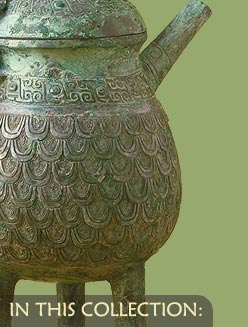 |
Few works of art are as remote or alien to western eyes as ancient Chinese bronzes. Nevertheless these beautiful ritual vessels constituted the mainstream of Chinese art for nearly 1500 years. Spanning both the Shang (1523-1028 B.C.) and Chou dynasties (1027-256 B.C.), these ceremonial utensils, often of unsurpassed technical refinement and varied decor, define the very essence of early Chinese art.
Ancestors and ceremonial conduct have always been of great importance to the Chinese and the majority of bronzes were originally used in the offering of wine and foods to the spirits in ancestral rites, state ceremonies, and various ritual sacrifices.
Bronze is primarily an alloy of copper, tin, and lead, and it was traditionally cast by the ancient Chinese in ceramic piece molds, a difficult process which allowed for the exceptionally fine details seen in the decor of these vessels. The metal was cast in a variety of functional shapes, and most of these ornaments, animal forms, weapons and vessels, some of which bear ancient inscriptions, were excavated from tombs where they had first been interred with the deceased in elaborate funerals. The warm , rich, blue-green surface or patina of these compelling artifacts is due to the natural oxidation of the bronze fabric which has occurred with the centuries of burial.
Much of this remarkable collection of Chinese bronzes, one of the finest of its type, was assembled and donated by Mr. Alfred F. Pillsbury for whom these vessels represented simply "the greatest of all arts."
|